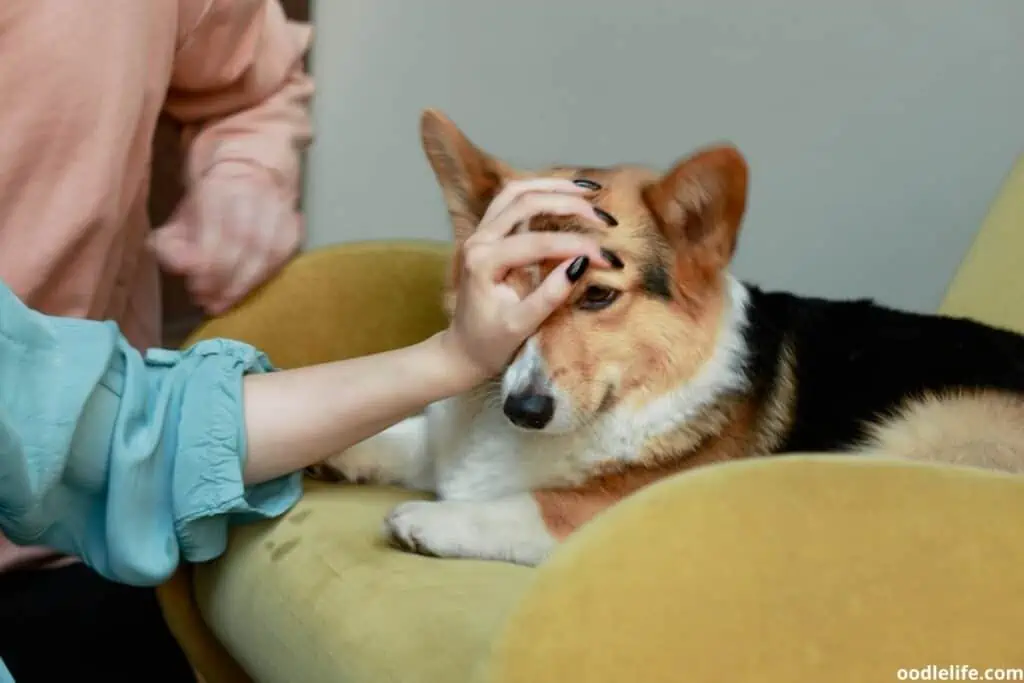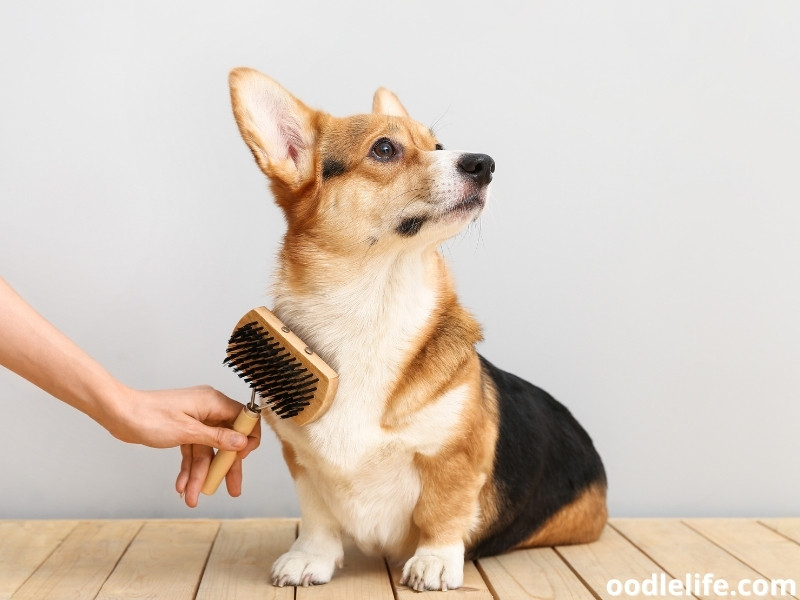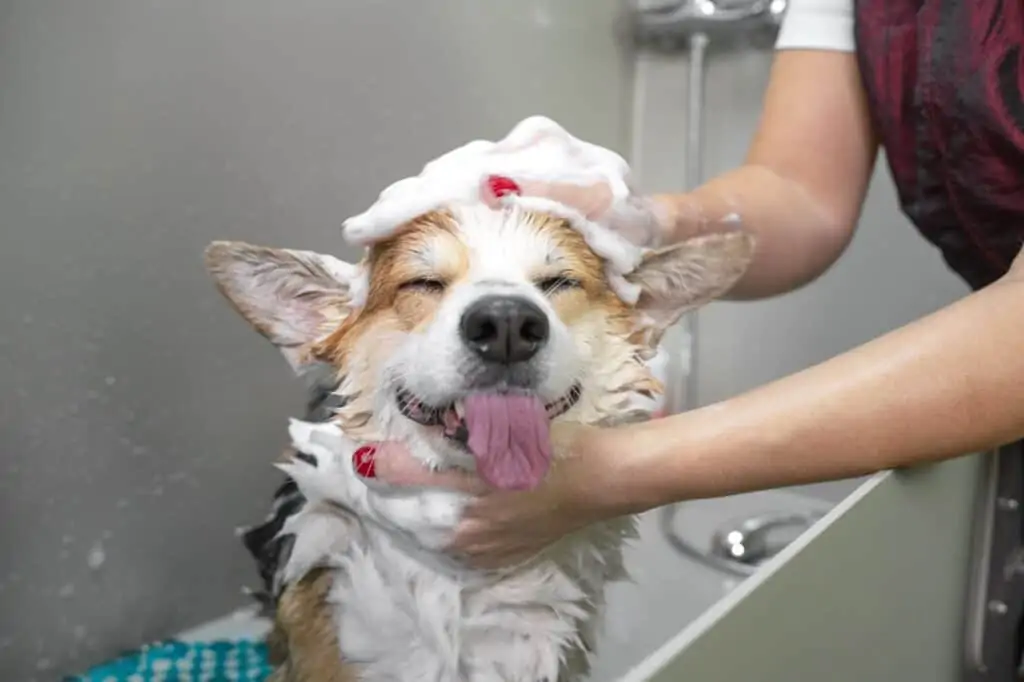Do Corgis Shed? (How To Stop Shedding?)
Corgis are a popular dog breed for any loving pet owner due to their friendly and playful nature and adorably fluffy fur. But, do Corgis shed? The answer is yes; Corgis do shed on occasion.
These lovable pups have a double-layer of that fluffy fur coat, which means they have a second, much thinner layer of fur underneath the fur we see on the outside.
This double-coat helps the pups regulate body temperature and keeps them dry. If you are prone to allergies, these pups may not be right for you, and you may want to consider a hypoallergenic breed.

As many dog lovers know, owning any double-coated breed typically includes cleaning up a lot of hairballs. The good news is that there are ways to keep shedding to a minimum. Let’s explore some of those ways and discuss why regular grooming is important for your dog’s health.
Monitoring your dogs shedding habits is a great way to keep track of their overall health.
The Breeds
Corgis have two different breed types. There’s the more commonly known Pembroke Welsh Corgi and the lesser known Cardigan Welsh Corgi. Both breeds have thick double-coats to keep them warm and fluffy.
While both pups are Corgis, they do have some differences.

The Pembroke Welsh is the smaller of the two, with an average weight of 30lbs and only reaching heights of around 10-12 inches. However, the Cardigan Welsh is only slightly larger, reaching heights of 10.5-12.5 inches and weighing anywhere from 24-38lbs.
Both breeds were designed for herding cattle, making them super strong and athletic dogs. Perfect for farms and families with children. They love to run around and play outdoors.
However, they are also great companions to snuggle up with after a long work day.
Whatever your reason for owning one, you are sure to love them!
Shedding Frequency
Both breeds of Corgis have a double-coat of medium-length fur. A double-coat means that they have a second, thinner, layer of fur underneath the top coat. This second layer helps to keep them well insulated and cool throughout the year.

Because Corgis are double-coated dogs, they will shed more frequently than breeds with only one layer of fur. Most dogs, including Corgis, will shed all year in some form. However, Corgis, like most double-coated breeds, tend to shed more frequently during the summer and winter.
During the winter, a Corgis coat will thicken to help keep them warm. Likewise during the summer, they will shed that thick coat to keep them cool. Frequent grooming is extra important during these two times of the year.
Corgis may not be the breed for you if you prefer a house free of fur. However, frequent grooming and brushing at least three times per week can help prevent a build-up of fur on furniture and keep your dog’s coat comfortable.
Other Causes for Excess Shedding
Seasonal changes may not be the only reason your dog is shedding. Diet, nutrition, stress, and other health problems such as allergies can play a role in your dog’s shedding habits. Allergies to things like grass, pollen, dust, or even the brand of shampoo you use can cause your dog to shed more.

Keeping up with vet check-ups can help to rule out what could be causing your shedding problems.
Maintaining a clean home can help with dust control if your dog has a dust allergy. Vacuuming daily around the house can help with this. You can even vacuum your Corgi!
Doing so can help remove any excess fur that brushes and bathes don’t remove, and it’s fun for the pup too!
Stress can also play a heavy role in your dog’s shedding. Hiccups in routine are sometimes unavoidable. However, keeping up with regular grooming can help reduce the amount of stress-induced shedding.
Removing other stress factors such as noise or smells can also positively impact your pooch’s overall well-being and how much they shed.

Diet And Nutrition
Keeping up with a good diet and nutrition plan is always important for maintaining overall health, but did you know they can also help keep your dog’s coat extra healthy. Keeping your dog’s diet well-balanced can have a positive impact on the amount of shedding you see.
Nutrient-heavy foods and foods high in Omega Fatty acids will keep your dog’s coat smooth and shiny, and keep their skin healthy. Keeping up with your dog’s diet is a great way to ensure they are healthy and happy, but keeps the unwanted hair to a minimum around the house.
Supplements can work in a pinch if you find that a good diet doesn’t do enough for the amount of shedding your dog does. However, the best way to keep your dog’s skin and fur healthy is with the proper diet and nutrition. Be sure to check with your dog’s veterinarian before making any fast changes to your dog’s diet, as this can induce stress.
Other Health Factors
Sometimes excess shedding can be caused by an underlying health condition. If you begin to notice your dog is shedding more than usual, be sure to have your dog examined by a veterinarian. Infections and other things, such as thyroid and adrenal disorders, can cause your dog to shed excessively.

How To Manage Your Corgis Shedding?
There are plenty of ways to help your pup keep their coats perfect all year round. Having a regular grooming schedule can dramatically reduce the amount your pup will shed. Daily brushing, especially during the winter and summer, can help keep that pesky fur off the furniture and your clothing.

If your pup of choice is the Pembroke Welsh, you may need to bathe your dog more frequently in the warm season to remove some of the undercoat sheddings. This is because the Pembroke Welsh has thicker fur than the Cardigan.
When it comes to the Cardigan Welsh, some pet owners believe it necessary to keep their pup’s coat trimmed in the warmer seasons. However, with proper care and maintenance trimming is usually unnecessary.
Feeding your Corgi a balanced and healthy diet is another way to help manage the amount of shedding your dog does. Keeping your dog hydrated, especially during the summer will help keep their skin and fur healthy.
A Corgi that is fed a healthy diet full of protein and omega fatty acids will help keep their skin and fur healthy and prevent excess shedding. And making sure that your dog is well hydrated, especially during the hot months, will help keep their fur healthy. And, if necessary, supplements can help replace missing nutrients in your dog’s diet.
Corgis nails can get pretty sharp, so keeping your Corgis nails trimmed can help as well. Trimming the nails will prevent them from scratching away sections of fur or creating mats in their fur when they scratch.
Bathing your dog at least once a month can help loosen up and remove much of the unwanted hair. Bathing regularly also gives you time to bond with your furry friend and check them for any physical blemishes or irritations to the skin.
Helpful Grooming Products
There are also tons of products to help keep your pup’s coat thin and cool. Having a good deshedder on hand is always a good idea. Deshedder, used at least twice per year, along with a good brushing regimen, will prevent hair mats from forming and keep your dog’s coat looking great all year.

Slicker brushes are a fantastic tool for brushing out the excess hair in your dog’s undercoat.
Shampoos can also be a great tool to keep shedding at a minimum. A good shampoo should leave your dog’s coat feeling smooth and shiny. If you find that your dog is still shedding more than you’d like, you can also try an anti-shed shampoo.
Anti-shed shampoos are used to help slow down some of that excess shedding.
Be sure to follow the guidelines set forth by whatever shampoo you choose. Overbathing can cause skin irritations that could lead to more shedding.
So, Do Corgis Shed?
Yes, Corgis do shed (so do Dorgi’s). Due to their double-coat, Corgis shed quite frequently all year round. However, they shed the most during the winter and summer. And while there is no way to avoid shedding entirely, there are tons of ways to manage the amount of excess hair lying around.
Having a regular grooming schedule will help maintain your dog’s healthy fur coat and cut down on unwanted shedding. Brushing your dog daily with a slicker brush and bathing them at least once per month will help loosen up any hair stuck in their coat. And, if necessary, using a deshedder or an anti-shed shampoo will help to get rid of excess hair.
Vacuuming your home daily can help to remove any dust or other allergens. If your dog’s excess shedding is due to allergies, a clean environment can help reduce the unwanted hair. This may help you as well if pet allergies are a problem.
Finally, keeping up with veterinary check-ups will help maintain your dog’s overall health. Regular check-ups will help catch any underlying conditions such as thyroid or hormonal imbalances that may be causing your dog to shed excessively. Maintaining your dog’s health is the most important way to decrease the amount of shedding you see.
In short, don’t let their shedding habits stop you from owning one of these adorable pups. Corgis are super friendly and loving dogs. They are a fantastic addition to any family.
And if all else fails, it’s always an option to keep your Corgis coat trimmed and short all year round.